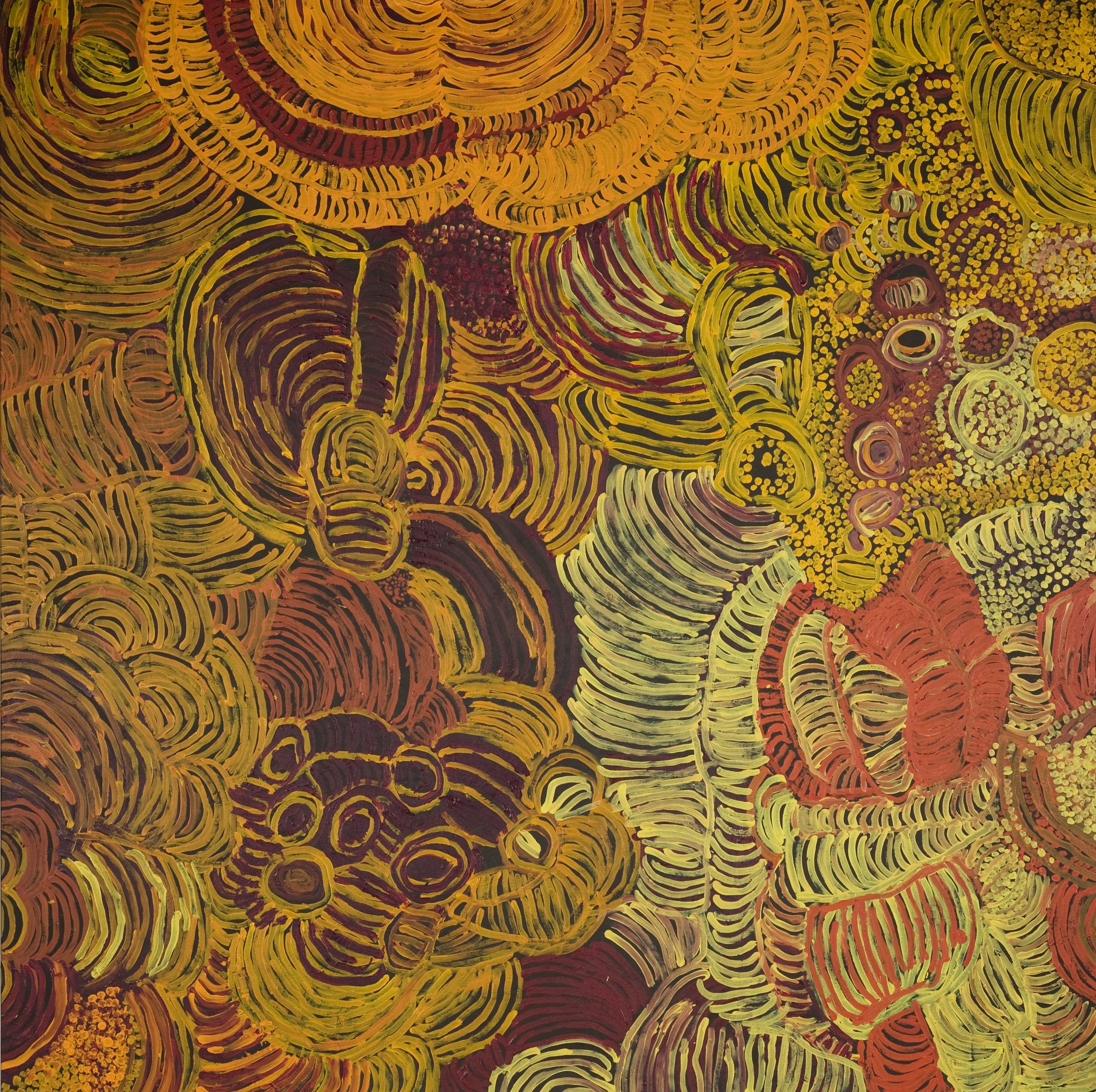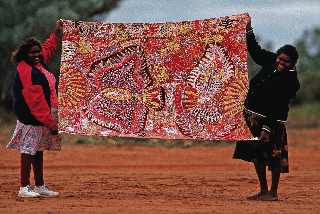ANANGU ART BROUGHT TO BOOK

Eileen Stevens 'Piltati' 2006, Synthetic polymer paint on canvas. 200 x 200 cms. Courtesy of the Merenda Collection
Jeremy Eccles | 27.06.10
Author: Jeremy Eccles
News source: Australia Art Market Report
“Now, almost forty years after its genesis, the epicentre and dynamic thrust of the Western Desert art movement has dramatically shifted from Papunya, Kintore and Kiwirrkura to Ngaanyatjarra and APY art centres. The untrammelled painting of senior men and women who are new to acrylic on canvas, but who share the same cryptic and powerful iconography, cultural law, song-lines of tjukurpa and towering compassion for country as their Western Desert relatives, are now taking the art world by storm”.
That's certainly the Big Picture as seen by Judith Ryan, Senior Curator of Indigenous Art at the National Gallery of Victoria. She was writing in the catalogue for Tjukurpa Pulkatjara, The Power of the Law, which was also the major visual art show at this year's Adelaide Festival. For this roaring new art movement has spread like wildfire across the Anangu Pitjanjatjara Yankunytjatjara Lands so that in the decade since that fire was lit in 2001, 12 art centres opened to serve 15 tiny and remote communities – compared to the decade it took for Yuendemu to follow the lead of Papunya when Aboriginal art first went public in all its complexity in 1971.
There's also a more intimate portrait of a particular group of mainly women artists who moved from the craft centre at Ernabella well before 2001 to establish Kaltjiti Arts at Fregon in a book by their long-time adviser, Diana James – Painting The Song. And, a little further back in time, there was the pioneering recognition of the new APY energy-source in the 2008 tome, New Beginnings, an enthusiastic compendium of collector Pat Corrigan's selection of the Aboriginal art that's happened in that same decade.
From a combined reading of all three I have learnt some of the answers to key questions concerning the mystery of why the Anangu people of the APY Lands waited until this century to join the Aboriginal art party. For history has always recorded Ernabella – the sheep station that became a mission in 1936 - as indisputably the first indigenous art centre in the country in 1948. And Diana James reminds us that it was there in 1940 that the anthropologist Charles Mountford gave brown paper and crayons to a number of people and asked them to draw “black-fellow marks” for him. The resulting 300 drawings (now in the SA State Library) reveal many of the motifs we all became familiar with after 1970 – the art inherent in sand painting, on cave walls, tjuringas and the ceremonial body which was given transportability for the first time.
Sadly, Mountford's superficial conclusion from this was that the men drew him important foundation myths while the women offered only images related to their hunting and gathering roles.
Of course, the women wouldn't have revealed their sacred images to a man – whatever his skin colour. But, history has shown that for any number of reasons, Ernabella's art was, and continues to be based around the women's analpa walka - beautiful flowing designs verging on realistic representation of plants and insects which were then applied to what we think of as 'women's arts' – weaving and rug-making, ceramics and, above all, batik patterning on silk or cotton material. The men, meanwhile were out and about husbanding animals, and when crafting, created punu, carved wooden animals, etc, decorated with lines burnt by hot wires.
Were these artistic inhibitions forced on them by white advisers? True, the redoubtable Win Hilliard was there for many a year – 32 in fact - during which she stuck manfully to her commission to develop the crafts. Later, an officious Aboriginal Arts Board at the Australia Council would try to restrict the Anangu to craftwork, leaving their northern neighbours, the Pintupi exclusively free to paint on boards and canvas.
But it seems that the real blockage was the religious intensity of the people themselves. The Anangu simply saw no purpose in revealing their spiritual secrets to this weird mob who'd ridden into their lives unbidden in the 1930s. In fact, the ban was so absolute that when Pitjanjatjara men saw early paintings by the first artists of Papunya which clearly revealed stories and songlines that were also part of their liturgy, they physically attacked both art and artists. Diana James believes that it took until 1977, after Papunya Tula artists had moved to disguise the spiritual details with dots and an increasing abstraction, before the Pintupi diplomat, Nospeg Tjupurrula was satisfactorily able to appease the Pitjanjatjara elders with a gift of scared objects
It's not for nothing that James's book title is Painting the Song. Her opening lines are: “Kaltjiti artists sing country, dance country, and paint the song of their land. The epic song cycles of the Western Desert peoples have resounded for thousands of years across these sand dunes of Central Australia, echoed back from the orange rock faces of the granite hills, and eddied around the deep blue rockholes where precious waters hide from the scorching sun”. James goes on to explain how song remains an essential part of a painting process she memorably calls “a quality of extroverted ecstasy”. And she concludes, “Painting the song on canvas metamorphoses the flesh of the Tjukurpa from aural tones into the bright tones of acrylic paint that dance before the eye of the beholder, enticing them to listen to the ancient rhythms of the land”
The brilliance of APY works right across the Lands as seen in both New Beginnings and Tjukurpa Pulkatjara, The Power of the Law reveals the full force of an art that's also urgently needed to pass law on to another generation. That's what impels a rites leader like Hector Burton of Amata, whose Caterpiller Dreaming paintings emerge spiritually hot from the songs that make the ceremonies.
Painting the Song by Diana James was published last year by McCulloch & McCulloch at $60
Tjukurpa Pulkatjara – The Power of the Law was published this March by Wakefield Press at $40
New Beginnings - Classic Paintings from the Corrigan Collection with texts by Emily McCulloch Childs was published in 2008 by McCulloch & McCulloch at $80
URL: www.mccullochandmcculloch.com.au
Share this:
»  del.icio.us
»
del.icio.us
»  Digg it
»
Digg it
»  reddit
»
reddit
»  Google
»
Google
»  StumbleUpon
»
StumbleUpon
»  Technorati
»
Technorati
»  Facebook
Facebook
Contact Details

Katie Curley and Inawintji Williamson holding Inawintji Williamson's 'Pinta-pinta Tjukurpa' (Butterfly Dreaming), 1992, batik on silk
Further Research
Artists: Diana James | Eileen Stevens | Hector Burton | Inawintji Williamson | Nosepeg Jupurrula | Pat Corrigan
News Tags: APY Lands | Ernabella | Kaltjiti | South Australian Museum | Susan McCulloch
News Archive
- 11.10.17 | RETURN OF MUNGO MAN
- 10.10.17 | TARNANTHI 2017
- 11.08.17 | Natsiaas 2017
- 08.08.17 | ABORIGINAL ART ECONOMICS
- 02.08.17 | SCHOLL'S NEXT MOVE
- 20.07.17 | APY ART DOMINATES THE WYNNE
- 17.07.17 | Anangu Artist Wins $100,000 Prize
- 14.07.17 | The End of AAMU
- 13.07.17 | YOU ARE HERE
- 11.07.17 | ART ACROSS THE COUNTRY
- 11.07.17 | TARNANTHI IN OCTOBER
- 05.07.17 | TJUNGUṈUTJA - from having come together
- 02.07.17 | BENNELONG
- 27.06.17 | JIMMY CHI
- 23.06.17 | Blak Markets at Barangaroo
Advertising

